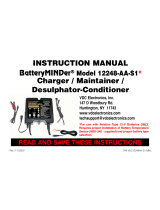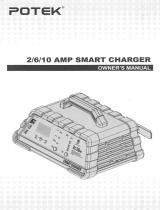Connecting tthe BBatteryMINDer PPlus wwhen BBatteries aare IInstalled iin
the EEquipment
Follow these instructions when battery is installed in equipment (vehicle, PWC,
boat, tractor, etc.). A spark near battery may cause battery to explode. To reduce
risk of a spark near battery:
1. Position DC output cord to reduce risk of damage by hood, door, covers, or
moving engine parts.
2. Stay clear of fan blades, belts, pulleys, and other parts that can cause injuries.
3. Check polarity of battery posts. The POSITIVE (POS, P, +) battery post usually
has a larger diameter than the NEGATIVE (NEG, N, -) post.
4. Determine which post of battery is grounded (connected) to the chassis of
equipment. If the negative post is grounded, see Item N. If the positive post is
grounded, see Item
P
.
N.
For negative grounded equipment, connect the POSITIVE (RED) clip from
the charger to the POSITIVE (POS, P, +) ungrounded post of the battery.
Connect the NEGATIVE (BLACK) clip to the vehicle chassis or the engine
block away from the battery. Do not connect the clip to carburetor, fuel lines,
or metal body parts.
P.
For positive ground equipment, connect the NEGATIVE (BLACK) clip from
the charger to the NEGATIVE (NEG, N, -) UNGROUNDED post of the battery.
Connect the POSITIVE (RED) clip to chassis or engine block away from the
battery. Do not connect the clip to carburetor, fuel lines, or sheet metal body
parts. Connect to heavy gauge metal part of the frame or engine.
5. When disconnecting the charger, disconnect it from the AC outlet, and then
remove the clips from the vehicle chassis, and the battery posts.
Connecting tthe BBatteryMINDer PPlus wwhen BBatteries aare OOutside oof
Equipment
Follow these steps when battery is outside of vehicle or equipment. A spark near
the battery may cause battery explosion. To reduce risk of a spark near battery:
1. Check the polarity of battery posts. The POSITIVE (POS,P,+) battery post usu-
ally has a larger diameter than the NEGATIVE (NEG, N, -) battery post.
2. Attach at least a 24 inch long 6-gauge (AG) insulated battery cable to the
NEGATIVE (NEG -) battery post.
3. Connect the (RED) charger clip to (POS+) the post of the battery.
4. Position yourself and free end of cable as far away from battery as possible,
and then connect the NEGATIVE (BLACK) charger clip to free end of the
cable.
5. Do not face battery when making final connections.
5

















